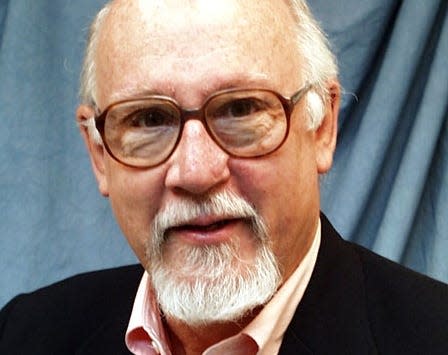Historian reveals complex story behind America’s first Vietnam War memorial | DON NOBLE
- Oops!Something went wrong.Please try again later.

Steven Trout, who is now chairman of the English Department at the University of Alabama, was for years the chair at the University of South Alabama and co-director of the Center for the Study of War and Memory. His previous books include an examination of how Americans’ perceptions of World War I were formed and changed over time and a study of the depictions of war in American fiction, especially and surprisingly the fiction of Willa Cather.
This new book, “The Vietnam Veterans Memorial at Angel Fire: War, Remembrance and an American Tragedy,” is in various direct and oblique ways about the war in Vietnam.
The memorial at Angel Fire, at 8,500 feet in the Sangre de Cristo Mountains northeast of Taos, is an architectural wonder. It is described as a startlingly white flame leaping more than 50 feet into the sky. It bears some resemblance to a giant bird’s wing, or an angel’s wing, a church steeple, a ship’s prow. It carries the gaze upwards, as religious monuments are supposed to do.
MORE FROM DON NOBLE: Madcap mystery explores cold cases
The chapel was opened in 1972 and was, until 1982, with the dedication of "The Wall" in Washington, D.C., arguably the only Vietnam veterans memorial in the country.
Trout tells the story of the building, maintenance and significance of this memorial in New Mexico, but what might have seemed a straightforward story to begin with got complex. “Angel Fire” contains the biographies of a father and son, a short study of family dynamics, lessons in military history and some further thoughts on how we Americans remember our wars, our dead, our past.
The father in this case was Victor Westphall, born 1913. Victor was a singular creature: a body builder, World War II Navy veteran, successful businessman, scholar with a PhD. In fact, Trout bestows, without irony, the title “Renaissance Man” on Victor.
Victor and Jeanne’s son David was born in January 1940.
David, like his father, was very bright and a fine athlete. But he had emotional problems, vague fears, unhappiness with his facial features. Victor, the dad, interfered constantly, criticized David’s coaches, put pressure on the boy to excel. David sometimes excelled and sometimes folded under pressure, in sports, in college, and in marriage.
He also became very patriotic and joined the Marine Corps; Lt. Westphall was killed just south of the demilitarized zone on May 22, 1968.
Victor and Jeanne were devastated. Jeanne had a nervous breakdown and a long recovery, and Victor commenced building the memorial. His aims were shifting, and not easy to understand or summarize.
There are difficult contradictions.
Victor, a proud vet himself, turned against any support of the war.
The chapel was to be a monument to his son who wholeheartedly supported the war, and to others who sacrificed, but was not meant to glorify the Vietnam War or any other. It would be a place of repose, tranquility, meditation, prayer. Victor, an advocate for universal peace, was far ahead of his time in 1972, to say the least.
Ten years later, the memorial designed by Maya Lin was built in D.C., a black stone wall with only names, stunning in in effect. Trout tells the reader, and this surprised me, that the National Korean War Veterans memorial came next, in 1995, and the World War II memorial not until 2004. I wrongly thought they were already there.
Anger at the wasteful and, in his opinion, stupid way the war was being conducted led Victor to announce that in addition to photos of fallen Americans, he would hang photos of deceased North Vietnamese soldiers including, if he could get it, a photo of the soldier who killed his son.
There is a great deal about the chapel itself, which from photos and descriptions must be an astonishing place, and the story of Victor’s task. He literally bankrupted himself and, applying for federal help, encountered obstacles both obvious and obscure. The location was difficult, not on U.S. Park Service land, and even though the country was shifting away from support for the war, no government agency was eager to support a memorial that included the North Vietnamese dead.
As Victor learned and we all know now, American feelings about monuments can change radically. Most statues of Nathan Bedford Forrest, Stonewall Jackson and Robert E. Lee now reside in vacant lots or old warehouses and the fates of statues of Thomas Jefferson and even George Washington are uncertain.
Finally, the Disabled American Veterans did help out and take over, making changes Victor really didn’t like.
Victor wrote steadily of his disgust with the war, including the financial costs.
The average B-52 strike in the north cost $40 million. If the strike killed 300 soldiers, that was $133,333 per soldier. If the war as a whole cost $240 billion, the cost was $343,000 per enemy fatality.
“Victor concluded it would have been cheaper ‘to buy each pro-communist soldier killed the finest country estate and lifetime annuity, than to kill him.’”
“Angel Fire” is the story of a lost Marine, a grieving father and mother, and commentary on the nature of memorials and Americans’ shifting attitudes towards war, from the “good” one in the 1940s to the failures of Vietnam.
Don Noble’s newest book is Alabama Noir, a collection of original stories by Winston Groom, Ace Atkins, Carolyn Haines, Brad Watson, and eleven other Alabama authors.
“The Vietnam Veterans Memorial at Angel Fire: War, Remembrance and an American Tragedy”
Author: Steven Trout
Publisher: University Press of Kansas, Lawrence, Kansas, 2020
Price: $55 (Hardback); $22.50 (Paperback)
Pages: 239
This article originally appeared on The Tuscaloosa News: Historian reveals story behind first Vietnam War memorial | DON NOBLE
